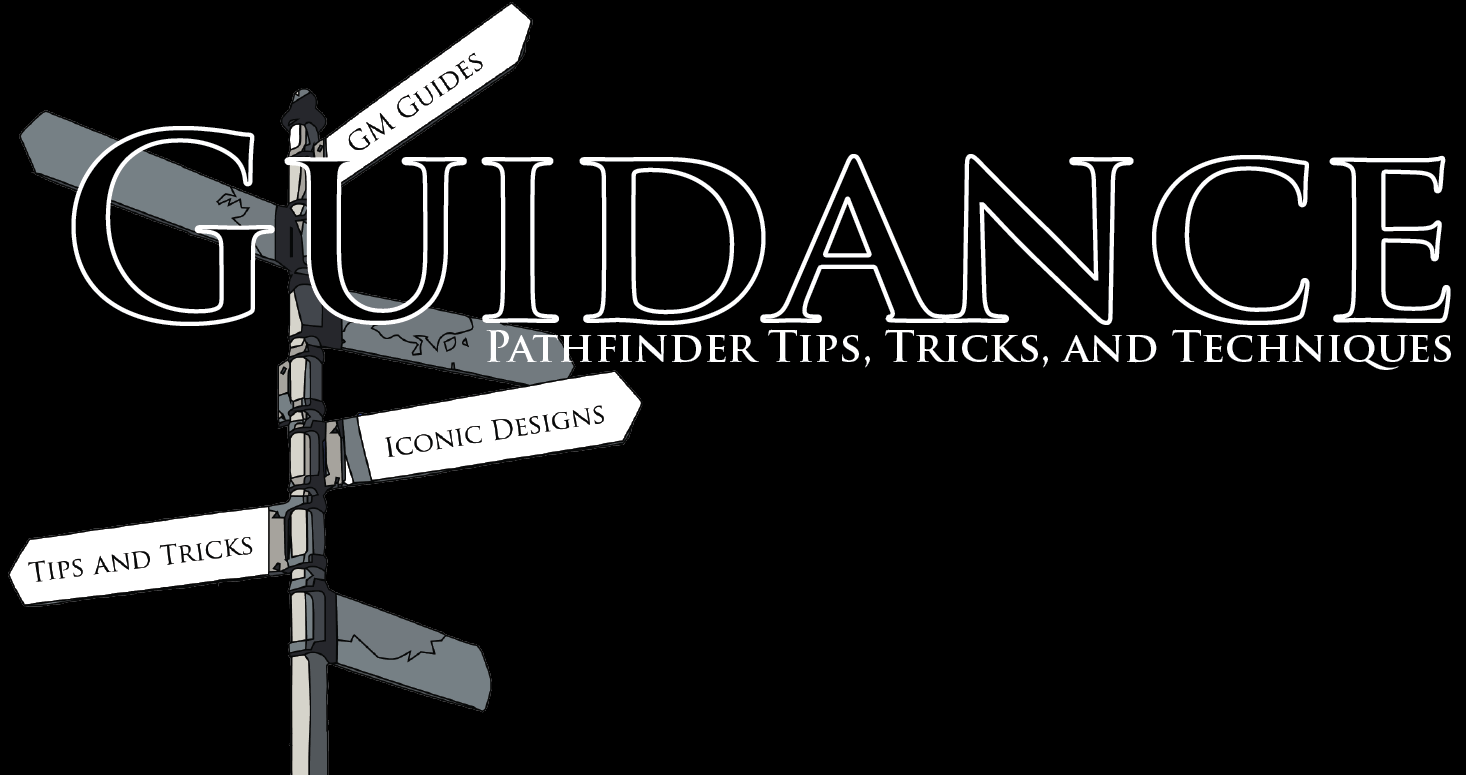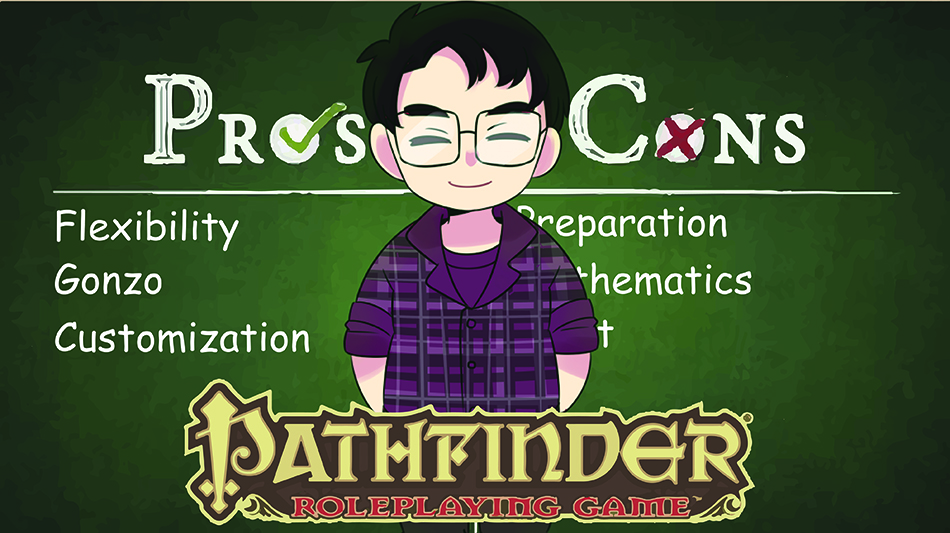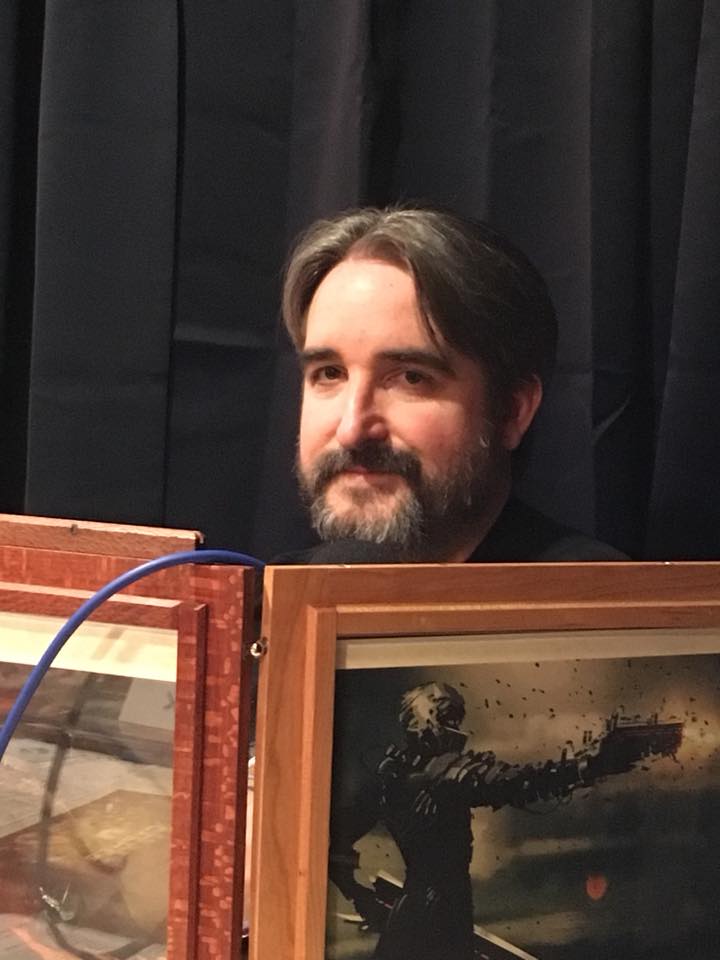Hello, wonderful Know Direction readers, and welcome to Guidance! As you might have heard on our Holiday Special, I’ve sorta-kinda officially announced that I’m working on my own Tabletop RPG for Everybody Games! If you’re interested, you can read a little bit about it here. And with that work comes a LOT of research! Part of designing a game is knowing how other designers tackled various issues and problems, after all. Fans tend to be pretty brutal if you repeat what they see as previous mistakes, after all.
So with that in mind, I’m going to be doing a series here I’m calling 5 Likes & Dislikes. I’m going to be touching on a few different Tabletop RPGs, starting with Paizo TTRPGs and branching off into others as I have the time to read them through. Over the next three weeks I’m going to be taking a look at Pathfinder 1E, Starfinder, and Pathfinder 2E in that order, and afterwards I’m hoping to have time to finish my thoughts on Shadows of the Demon Lord, Tales from the Loop, and Big Eyes, Small Mouth 1E. But who knows? Maybe by the time I finish the Paizo games I’ll need a break.
Maybe.
Let’s get started!
Like 1: Customization
Your ability to customize your character in Pathfinder 1st Edition is second to none right now. There are over 30 classes and you can freely multiclass between them however you want. There’s over 40 different playable ancestries to choose from, many of which have alternate racial traits that allow for further customization, and literally hundreds of feats. That’s sort of the advantage of a mature system; there’s just so much amazing content for it that you can pretty much build whatever you want.
Dislike 1: The Math Engine
I don’t think that Pathfinder 1E’s Math engine was really ever designed to work. After all, it was basically uplifted from the 3.5 Math engine, and most of the problems we see in Pathfinder 1E are carry overs from that game, exacerbated by the fact that Pathfinder 1E is a very high-power version of Dungeons and Dragons 3.5. Way back in the day before I made the jump to Pathfinder (back when I was mostly playing D&D 3.5), I actually lauded the system for it’s rampant player power, and this was back when there was only the Core Rulebook to go off of. Pathfinder has almost a dozen different kinds of bonuses, and the game’s monsters simply can’t handle that. It’s too many variables for making a balanced combat.
When looking at this issue, I’m reminded of the difference between World of Warcraft and Classic World of Warcraft. During the early days of World of Warcraft (especially the Burning Crusade), basically every class brought powerful buffs that you wanted in your raid. Warriors had battle shout, paladins had blessings, priests had Power Word: Fortitude, mages had arcane intellect. I could literally go down the list of all 10 classes that were in the game at the time, note any one of them, and each brought a powerful buff to the raid that you absolutely needed. Then a lot of that vanished between Wrath of the Lich King and Cataclysm. Why? Because the WoW Developers came to the same realization that the Pathfinder Design Team probably came to when making Pathfinder 2E—if you have too many variables, you either have to encourage your players to find ways to acquire all of them or you have to live with the fact that groups that have all will be significantly stronger. In World of Warcraft, this meant “bring the class” over “bring the player.” In Pathfinder, it means picking the same six items over and over again and using the same cookie cutter builds because their math was so strong that there was never any real risk of failure or defeat. Both of those things negatively impact the respective game’s fun in some manner.
The mathematical disparity causes numerous problems throughout the game, the biggest one being that it actually created two separate “needs” within the community. If I might draw comparison to World of Warcraft again, one of the things Warcraft raiding is famous for is the sliding scale of difficulty in the game. You can play “Normal” raids which are accessible to nearly everyone, “Heroic” raids that are significantly more challenging, and “Mythic” raids which are accessible only to the top 10% of players in terms of their difficulty. Pathfinder 1E developed two separate communities of players—a “Normal” player base that consists of people who are either new to the game or enjoy the baseline power level, and a “Mythic” player base that is entertained by high power levels and intricate levels of optimization. And where World of Warcraft’s rules are GMed by a computer programmed to be able to flawlessly execute both Normal and Mythic raids, your GM in Pathfinder is a person who might not have that same level of competency, and more over, they might not find it fun to develop the skills and invest the extra time into painstakingly customizing every encounter to their players’ abilities. We can’t all be Mark Seifter, after all!
Like 2: Choice is Significant
With some exceptions, every character in Pathfinder 1E makes a significant choice at every new level. Whether you’re getting a feat or choosing a new class feature or spell, you have choices to make all the time and one could say that a PF1 character is the sum of those choices. Knowing that a character’s effectiveness is the result of your own smart planning is an immensely satisfying feeling, and it’s one of the driving forces of Pathfinder 1E.
Dislike 2: Trap Choices
For every significant choice you can make in PF1, there are an equal number of choices that are traps. A trap choice is an option that looks deceivingly good on paper, but in practice it’s a waste of space. There are PLENTY of feat choices and class feature choices and archetype choices that are notorious traps for one reason or another. A particularly infamous one was the original version of the Prone Shooter feat, which had an effect that was already baseline for all characters. In a sense, it did nothing. There are also plenty of archetypes that are considered traps because they make generally poor trades or worsen the capabilities of the characters who take them. Part of the issue with PF1 is that system mastery makes you a god, but not having system mastery (or ignoring it for other reasons) can cause you to make bad choices.
Like 3: It’s Familiar
I think that this like is going to be the thing that draws a ton of people into PF1 now. PF1 uses a game mechanics engine that we’ve been playing with for, what, over 30 years now? As a result, if you’ve been playing the 3.0 / 3.5 engine for a long time, the game feels REALLY familiar. Moreover, if you’re internet savvy it’s VERY easy to find some really good content from content creators on the web that help you with your builds and with understanding basic game design ideals. This is something a new game doesn’t end up having for a while; experts who’ve played the system, run it through it’s ropes, and can speak with experienced authority on the topic.
A great example for how a newer game and end up suffering for not having this kind of authority comes from Starfinder. For a long time, there were a ton of players who ragged hard on the envoy and the soldier early on in Starfinder’s life while extolling the virtues of the operative. “The soldier,” they said “Doesn’t do nearly enough damage to keep up with the operative and the operative just gets more, more, more! The envoy stops getting meaningful abilities after 8th level and doesn’t have anything they really bring to the party because they can’t bring damage. Damage kills monsters!” Now a few years later, the community mostly agrees that those three points aren’t true. The soldier effortlessly out damages the operative round per round, the envoy’s party buffs and debuffs are invaluable, and the operative (while good) supports a number of specific playstyles that don’t necessarily make it the burst-master of the PF1 rogue. These are things that took time to figure out because players and GMs weren’t familiar with the system and it’s expectations.
Dislike 3: Needless Complexity
For everything I love about PF1, it’s got a lot of needless complexity. These are mechanics whose presence doesn’t really add anything significant to the game. A great example is Hit Dice. I loathe Hit Dice as they’re implemented in PF1, as they basically only exist as a mechanic that prevents some effects from working against some monsters. For example, if you have a human who has 10 Hit Dice, you can’t affect it with the daze spell. Despite them being Level 10. This mechanic basically exists only to ensure that monsters are different at a superfluous level, as the value of a Hit Dice doesn’t really exist and the Hit Dice you set your monster at isn’t as important as the numbers they get from it. That the process for determining Hit Dice differs for every creature type makes it more unwieldy, and I’ll even go as far as to say that this mechanic is what makes monster design so difficult for new GMs. It shouldn’t be.
Another place where complexity rears its ugly head is in feat taxes. TONS of feats have taxes for no other reason than A) tradition or B) as a way to give a minimum character level for a combat feat that a fighter can bypass by virtue of having more feats than anyone else. This ends up leading into fighting styles where you’re basically locked in to specific choices from Level 1, and if you didn’t start working towards a chain before you even built the character there’s zero chance of you ever getting the feat later. And plenty of feats have requirements that don’t even build well off of one another. For me, the most famous is how Whirlwind Attack needs Spring Attack. WHY? What about those two feats is helpful?
But still, nothing compares to needless complexity as much as Precise Shot and the firing into melee rule. That rule (and Precise Shot by extension) literally exist to ensure that people who specialize in ranged combat are better at it than people who don’t. Nothing more, nothing less. It requires 3rd level (1st if you’re a fighter) and exists only to take away a penalty that’s designed to make sure that someone who wants to be ranged is better than someone who flirts with the notion of bows and arrows. It’s needlessly complex and it’s design that’s actively unfriendly towards the players.
Like 4: Crazy Gonzo Action
It’s common knowledge that high-level Pathfinder is like a super heroes game where people are throwing out insanely potent effects left and right, where gods rip mortal souls asunder only to watch as they come crawling back from the brink anyway. High-level Pathfinder is really a different kind of game, and MAN, when you get a group together that’s all playing at that same high-power level with a GM who can throw challenging encounters at you, Pathfinder 1 feels incredibly good. One of my favorite Pathfinder 1 experiences of all time has to be the Passing the Torch series; me and a group of friends (that included James Ballod) played both two parters on hard mode at the highest possible tier, and I must say readers, I have NEVER played a game like it. I ache in my heart for that level of power and subsequent challenge, and it’s a feel that neither PF2 nor SF can replicate unfortunately.
Dislike 4: Building Anything Takes FOREVER
Hey, remember how I mentioned I loved the Crazy Gonzo Action? You might be asking yourself, “Alex, if you love it so much why don’t you run games like that?” Because, my dear friends, building anything from PCs to monsters to encounters in PF1 takes FOREVER. Skill ranks take forever. Spending gold takes forever. Building monsters using Bestiary’s rules takes FOR-EV-ER. Tweaking monster stats to the myriad of player options and capabilities takes FOREVER. In PF1 you can’t really make assumptions about player power; the bonuses are so all over the place that you basically have to take every player’s numbers and use them to build challenges. It’s painful, time consuming, and often requires you to rewrite entire stat blocks just to get an inkling of a challenge. And the worst part is that there’s no easy way to do this. You gotta customize everything to your group to a degree, and it just takes FOREVER.
Like 5: Room for Trade-Offs
One of the best part of PF1 that you don’t see in PF2 or SF is this idea that if you build a character with weaknesses, gear and equipment exists that allows you to shore up those weaknesses. For example, if you decide to prioritize Strength over Intelligence at 1st level, PF1 has easy ways to help you play catch up if your character should have a good bonus in some Int-based things. There are tons of different skill bonuses, items that boost ability scores, and more. While you can use the system to push yourself over the top, you can also use the system to make more balanced character choices that the base rules don’t allow you to do at first level, which feels REALLY good. SF and PF2 (especially PF2) don’t really have this option; it’s why Altronus, the iconic Solarian pregen, is so notoriously bad in Starfinder Society until his Level 5 incarnation where he gets a better array of ability score adjustments from leveling up.
Dislike 5: Paizo Never Embraced the Gonzo
For me, one of the strangest side effects of PF1’s design is that outside of Pathfinder Society (which has some of the best designed, challenging encounters out of the company’s entire product line), Paizo never actually put any effort into designing challenging content. Everything was always designed at the so-called 3.5 baseline, with the game never really going into the gritty in how to play high power games. Sometimes I wonder if a majority of people at Paizo don’t like building high-powered characters for one or more of the reasons I talked about here, but oh man is it FUN to have an insane group of characters! It’s why it disappointed me when I ran my first Adventure Path (Strange Aeons) and I realized just how low the bar was actually set. Sorry if this sounds like I’m calling out people who enjoy that level of play difficulty; I’m not trying to, but I’m legit disappointed that a game about fighting Cthulhu monsters isn’t designed to be Paizo’s one really difficult AP. Ultimately, running Strange Aeons sort of opened my eyes to where the majority of Paizo’s customers probably are in terms of the power level of the games they’re playing, and it sort of left me with this weird paradox—do I redesign everything and make it sufficiently challenging for the high-powered group I have, or do I leave it as-is and preserve the Paizo-intended integrity of the game? Ultimately I decided on a mix of the two; I only changed important set piece encounters and left all the other ones the same. That worked for me, but MAN what I wouldn’t give for Paizo to hand the reigns over to Linda Zayas-Palmer and John Compton for an AP series; have them make an AP of adventures tuned at the level of games like Salvation of the Sages and Passing the Torch!
In Conclusion,
I think Pathfinder 1 is a game system that allows for unparalleled customization at the cost of peerless complexity. As you advance in the game, you need to increasingly custom-tailor games to your players in order to offer them challenges to the limitless no-holds-bars of the system. While I think the game’s ability to make the players feel like they built the perfect character is second to none, the fact that it puts so much strain on the GMs to meet that rising uptick in power almost made it certain that eventually the game would have to evolve and change, if only to make running the system less stressful for the GM.
I hope you all enjoyed my Likes and Dislikes of Pathfinder 1E. Next time I want to take a gander at Starfinder, and conclude with a look at PF2. I’m not sure if I’m going to do these straight or put some Iconic Designs in between; maybe you can lend me your thoughts? Tag me on Discord in our Blog Discussion section and let me know which you prefer! Until next time, ciao!

Alexander “Alex” Augunas, the Everyman Gamer, has been playing Tabletop Roleplaying Games since 2007 after a friend pretended to be his father in order to smuggle him out of high school so his gaming group had enough people to run a module. Today, Alex is the owner and publisher of Everybody Games, a co-host on Know Direction: Beyond and RPG Design Club, and a player on Stellar. You can follow Alex’s exploits on Twitter (@AlJAug), on Facebook, or on Patreon. Know Direction fans are also welcome to “@Alex” him on the Know Direction discord server!





